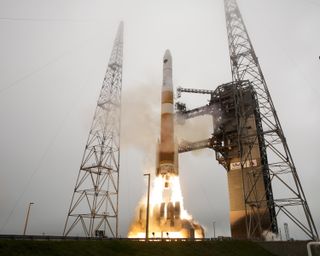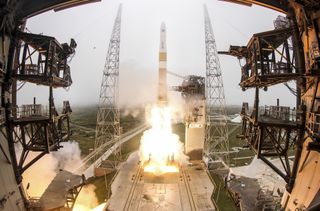
The U.S. Air Force has launched an advanced new satellite to help upgrade the nation's Global Positioning System (GPS) constellation.
The GPS IIF-9 satellite blasted off atop a United Launch Alliance Delta IV rocket from Florida's Cape Canaveral Air Force Station Wednesday (March 25) at 2:36 p.m. EDT (1836 GMT).
"I'm elated with today's successful launch," Brig. Gen. Bill Cooley, director of the Global Positioning System Directorate at the Air Force's Space and Missile Systems Center, said in a statement. "The GPS constellation remains healthy, strong and robust, and in over 20 years since initial operational capability, GPS has never failed to deliver on its global positioning, navigation and timing commitments."


The IIF-9 spacecraft joins 30 other operational GPS satellites in Earth orbit. It should come into service about four to six weeks from now, Cooley said.
GPS satellites fly in medium-Earth orbit (MEO), at an altitude of about 12,550 miles (20,200 kilometers). The constellation consists of 24 "core" spacecraft, plus a number of on-orbit spares to ensure redundancy and continuity of coverage.
The satellites in the network range widely in age. GPS IIF-9, for example, will likely replace a spacecraft that launched in August 1993. That older satellite is one of three members of the "IIA" series that remain operational.
The IIA satellites launched from 1990 through 1997. The GPS constellation also currently includes 12 operational "IIR" satellites, which blasted off from 1997 through 2004; seven "IIR(M)" craft, which took flight between 2005 and 2009; and, with the addition of the newly launched satellite, nine IIF vehicles.
Get the Space.com Newsletter
Breaking space news, the latest updates on rocket launches, skywatching events and more!
The Air Force plans to launch a total of 12 GPS IIF satellites, with the last one currently scheduled to lift off in January 2016. (The next group to launch will be the GPS III block satellites, which are now being built.)
"A path forward is in work to modernize GPS, and the IIF capability plays a vital role, updating the GPS constellation and maintaining the high level of accuracy required by the GPS system," Cooley told reporters during a prelaunch news conference last Friday (March 20).
Compared to previous GPS satellites, the IIF spacecraft feature improved accuracy (thanks to advanced atomic clocks), better signal strength and quality, and more civilian bands, Air Force officials have said. The latest spacecraft line also has a 12.5-year design life, whereas that of the IIA, IIR and IIR(M) was 7.5 years.
Boeing builds the IIF satellites for the Air Force. Each spacecraft costs $122 million to build in year-2000 dollars, Cooley said.
Follow Mike Wall on Twitter @michaeldwall and Google+. Follow us @Spacedotcom, Facebook or Google+. Originally published on Space.com.
Join our Space Forums to keep talking space on the latest missions, night sky and more! And if you have a news tip, correction or comment, let us know at: community@space.com.

Michael Wall is a Senior Space Writer with Space.com and joined the team in 2010. He primarily covers exoplanets, spaceflight and military space, but has been known to dabble in the space art beat. His book about the search for alien life, "Out There," was published on Nov. 13, 2018. Before becoming a science writer, Michael worked as a herpetologist and wildlife biologist. He has a Ph.D. in evolutionary biology from the University of Sydney, Australia, a bachelor's degree from the University of Arizona, and a graduate certificate in science writing from the University of California, Santa Cruz. To find out what his latest project is, you can follow Michael on Twitter.
